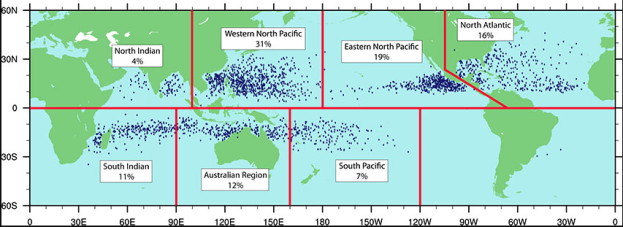 This post summarizes a new assessment by the World Meteorological Organization (WMO) of tropical cyclones and climate change in the Western North Pacific Basin (WNP). The WNP experiences about a third of total global tropical cyclones (figure above) and also has about a third of global population.
This post summarizes a new assessment by the World Meteorological Organization (WMO) of tropical cyclones and climate change in the Western North Pacific Basin (WNP). The WNP experiences about a third of total global tropical cyclones (figure above) and also has about a third of global population.
The new WMO assessment further reinforces the conclusions of all major assessments of tropical cyclones (including hurricanes) that the the detection and attribution of trends due to human-caused climate change has not been achieved.
The new assessment:
Lee, T. C., Knutson, T. R., Nakaegawa, T., Ying, M., & Cha, E. J. (2020). Third Assessment on Impacts of Climate Change on Tropical Cyclones in the Typhoon Committee Region–Part I: Observed Changes, Detection and Attribution. Tropical Cyclone Research and Review.
Details after the break.
For the bottom line conclusions:
- No trends in landfalling or affecting tropical cyclones in the region
“Observations from the Members did not reveal statistically significant trends in the frequency of landfalling or affecting TCs for China; the vicinity of Hong Kong, China; Macao, China; Japan (TC or above); the Philippines; or the Korean Peninsula.”
- With respect to the possible role of human-caused climate change on any variable related to tropical cyclone trends in the WNP, the paper concludes, under the conventional framework for detection and attribution of the IPCC, that there is low confidence* in either detection or attribution:
“Using the conventional perspective of avoiding Type I error (i.e., avoiding overstating anthropogenic influence), the strongest case for a detectable change in TC activity in the WNP is the observed poleward migration of the latitude of lifetime maximum intensity (LLMI). There is low-to-medium confidence that the observed poleward migration of the WNP basin LLMI is detectable compared with the estimated natural variability of TC activity in this basin. However, there is only low confidence that anthropogenic forcing had contributed to this poleward shift. There is low confidence that any other observed TC changes in the WNP are detectable or attributable to anthropogenic forcing.”
*The paper defines low confidence as its lowest confidence level: “Inconclusive evidence (some published evidence, but: extrapolations, inconsistent findings, poor documentation or data or methods, untested methods), poor physical understanding of mechanisms, disagreement among experts.”
Some further details:
Overall tropical cyclone activity in the basin:

Tropical cyclone trends for China, Japan, South Korea and Thailand:

